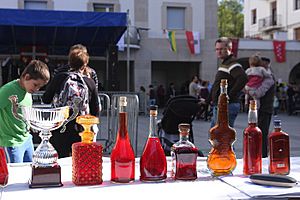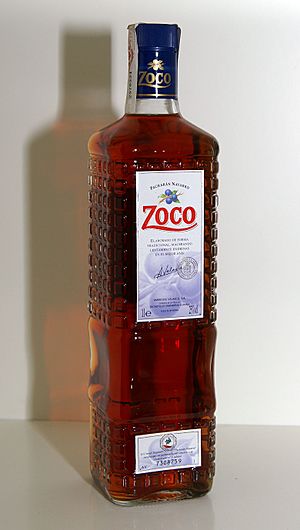Patxaran facts for kids
Patxaran is a sweet, reddish-brown drink, a bit like a liqueur, that comes from Navarre, a region in Spain. It's made using a special fruit called a sloe berry, which grows on the blackthorn bush. People often enjoy Patxaran after a meal, sometimes chilled or with ice, as it's thought to help with digestion.
Contents
What Does "Patxaran" Mean?
The name Patxaran comes from the Basque language, which is spoken in parts of Spain and France. It's a mix of two Basque words: basa, meaning 'wild', and aran, meaning 'sloe'. So, Patxaran basically means 'wild sloe'. You might hear it called Pacharán in Spanish-speaking areas.
How Patxaran is Made
Patxaran is made by soaking sloe berries, which are small, dark fruits from the blackthorn shrub. Along with the sloes, a few coffee beans and a cinnamon stick are added to a sweet, clear alcohol called anisette. This mixture is left to soak for a few months, usually between one and eight months.
This soaking process is called maceration. It helps the flavors and colors from the sloes, coffee, and cinnamon blend into the anisette. The result is a slightly sweet, reddish-brown drink that usually has about 25-30% alcohol. Rules for making Patxaran in Navarre say that no extra colors or flavors can be added, keeping the drink natural.
A Look Back: Patxaran's History
Patxaran has been around in Navarre for a very long time, even as far back as the Middle Ages. For many years, it was a special drink that families made at home, especially in the countryside. It started to become more widely known in the late 1800s.
In the 1950s, people began to make and sell Patxaran in larger amounts. It quickly became popular outside of Navarre, all over Spain. One idea why it became so famous is that young people from Navarre would take bottles of Patxaran with them when they traveled, sharing it with friends and spreading its popularity.
Today, Patxaran has a special status called PGI (Protected Geographical Indication). This means that to be called "Patxaran", it must be made and bottled in specific areas of Navarre, following traditional methods. This helps protect the drink's unique identity and history.
Popular Patxaran Brands
Many companies make Patxaran today. Some of the well-known brands you might see include Zoco, Etxeko, Basarana, Berezko, Usua, La Navarra, Las Endrinas, and Baines.
Each year, about seven million liters of Patxaran are made and sold by these companies!
Images for kids
See also
 In Spanish: Pacharán para niños
In Spanish: Pacharán para niños




